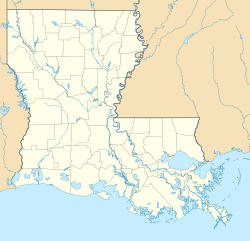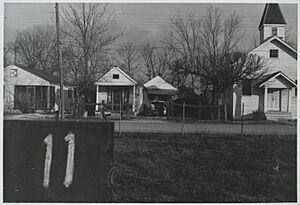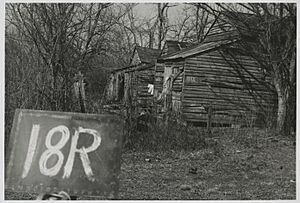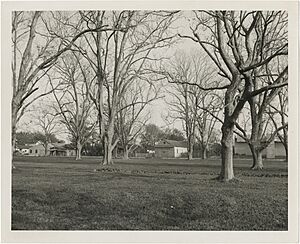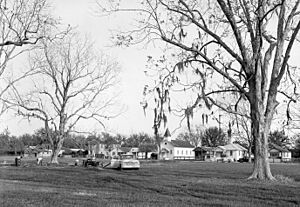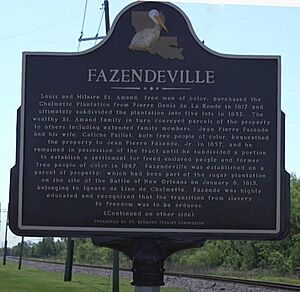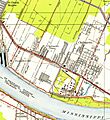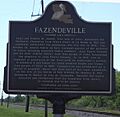Fazendeville, Louisiana facts for kids
Quick facts for kids
Fazendeville, Louisiana
|
|
|---|---|
|
Extinct, 1966
|
|
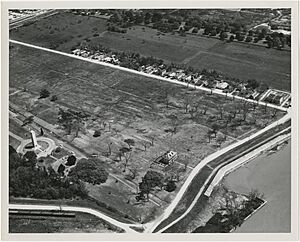
Fazendeville and the Chalmette National Cemetery and Chalmette monument, aerial view from southwest, 1963
|
|
| Nickname(s):
The Village
|
|
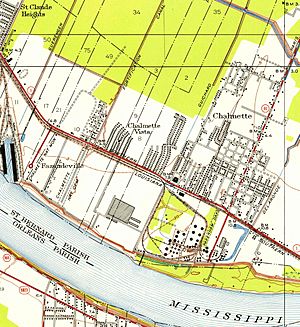
1951 United States Geological Survey map showing Fazendeville's geographic relationship to the Chalmette Battleground and town of Chalmette
|
|
| Country | United States |
| State | Louisiana |
| Parish | St. Bernard |
| Time zone | Central (CST) |
| • Summer (DST) | CDT |
| Village demolished between 1964 and 1966 to consolidate property into U.S. federal park land of Chalmette National Battlefield. Residents resettled mostly in 9th Ward of New Orleans. | |
Fazendeville was a small, historic African American community. It was located in St. Bernard Parish, Louisiana. People who lived there called it "The Village."
This community was near the Freedmen's Cemetery. In the 1960s, Fazendeville was completely removed. This happened because the Chalmette National Battlefield needed to expand. Today, this area is part of the Jean Lafitte National Historic Park and Preserve. Many families from Fazendeville moved to the Ninth Ward in New Orleans.
Contents
History of Fazendeville
Fazendeville was a self-sufficient village. It had its own general stores. There was a one-room schoolhouse for grades one through eight. The community also had two helpful societies. The Battle Ground Baptist Church was an important place.
The main street was Fazendeville Road. It ran from St. Bernard Highway to the River Road. Houses were on one side of the road. An open field behind the houses was used for baseball. There was also a large group of pecan trees.
Many homes in the village were built in a style called the shotgun house. These houses were long and narrow. Rooms were placed one behind the other. A front door and a back door were directly across from each other. People said a bullet fired from the front could go straight through to the back.
How the Village Started
In 1854, the land for Fazendeville belonged to Jean Pierre Fazende. He was a "free man of color." His son, also named Jean Pierre Fazende, inherited the land. After the American Civil War, the younger Fazende divided his farmland into smaller pieces. He sold these pieces to formerly enslaved people. This is how the Black community of Fazendeville began around 1867.
The Battle Ground Baptist Church was founded on April 16, 1868. Over the years, the village grew to have 33 lots on one street. By 1888, state records showed seventeen families lived there.
Social groups also formed in the village. In 1881, residents created the Progressive Mutual Aid and Benevolent Association. This group helped members with medical care and burial costs. Early leaders included Homer Charles and Carl Cook.
On New Year's Day in 1890, Fazendeville residents celebrated the Emancipation Proclamation. This was the order that freed enslaved people. They had speeches and a concert by the Chalmette Brass Band. Newspapers often wrote about the village's active concert bands. In 1898, leaders planned an event to raise money for sidewalks. In 1899, they planned another event for public improvements.
Early 1900s Life
In April 1902, Fazendeville residents decided to open a new school. It would be in the basement of the Progressive Hall. On October 12, they held a festival to raise money for the First Ward Colored School. The community worked hard to fund their school. The festival had baseball games, dancing, and foot races.
Around 1903, a railroad company, the St. Louis–San Francisco Railway, tried to buy land in Fazendeville. They wanted to expand their rail lines. The company offered to move Fazendeville residents to a smaller village nearby called Versailles. However, many Fazendeville residents said no to the offers.
Some people did sell their land to the railroad. Homer Charles, who owned the Chalmette Grocery Store, sold his property. His store was on the corner of Fazende Lane and the Levee. He and his family could stay until the company needed the land.
In 1905, property owners asked for a new road. This road would be behind the village. It would help them stay connected to the outside world. A committee was formed to look into this.
The second Battle Ground Baptist Church was opened on April 9, 1911. On September 28, 1919, the church held a big celebration. They welcomed home soldiers and sailors from World War I.
The 1920s and 1930s
In 1922, the St. Bernard Parish School Board visited the Fazendeville School. They found the conditions were not good. But they could not fix them at that time.
In 1923, a group called the Daughters of 1776-1815 asked for a new public road. This road would go between Fazendeville and the Chalmette Monument. The old private road was in bad shape.
On January 9, 1927, a big fire swept through Fazendeville. It destroyed the old Battle Ground Church. Seven cars and eight houses were also lost. About sixty people became homeless. They lost all their belongings. None of the homes were insured. The total loss was about $25,000. The foundation for a new Battle Ground Baptist Church was laid in October 1928.
In October 1928, the Fazendeville school had 65 students. In 1930, a water line was approved for the village. This would bring water to the homes.
By 1931, there were talks about buying Fazendeville land. This was for a national park at the Chalmette Battlefield. Many homes were still owned by the families who first settled there.
The Battle Ground Baptist Church celebrated its 65th anniversary in 1933. In 1934, the church lost two pastors. The Rev. John Minor died during a sermon. He had taken over from the Rev. C.C. Cager, who died earlier that year.
In 1939, it seemed likely that the Chalmette National Park would expand. This meant Fazendeville would probably be bought out. U.S. Congressman Joachim O. Fernández worked to get the government to buy the land. President Franklin D. Roosevelt first said no. He said the government did not buy land for national parks. But Congressman Fernández kept pushing for it.
Newspapers discussed where Fazendeville residents might move. They had to consider segregation. New sites were offered in other areas.
The 1940s and 1950s
In 1944, Fazendeville's Silver Star and Progressive Benevolent associations got permission to build a new road. This road would go from the village to their cemetery in Versailles. By 1948, some land for the national park expansion had been bought. But Fazendeville, which was 62 acres, was not yet purchased.
Another big fire hit the village on January 30, 1949. A kerosene heater exploded. Three double houses were destroyed. Six families lost their homes, food, clothes, and belongings.
In 1950, the St. Bernard Parish School Board closed most Black schools. Fazendeville students were bused to a new school in Violet. In 1953, a large baptism ceremony was held in the Mississippi River at Fazendeville.
Mrs. Edwin X. deVerges, who led the Chalmette National Historical Park Association, asked Congress to buy Fazendeville. In 1959, the Kaiser Aluminum & Chemical Corporation donated land next to the battlefield. This helped the park's formation.
The 1960s and the End of the Community
On February 27, 1961, U.S. Congressman F. Edward Hébert introduced a bill. It was to celebrate the 150th Anniversary of the Battle of New Orleans. His bill also planned to add about seven acres to the Chalmette National Historical Park. This land was along Fazendeville Lane. It was owned by many individuals, mostly Black families.
On October 12, 1962, President John F. Kennedy signed the bill into law. This allowed the purchase of land along Fazendeville Road for the park.
The community of Fazendeville officially ended in 1964. The St. Bernard Parish Government took the land for the park's expansion. Some people believed this was also to move the largest group of Black residents out of the Parish.
More than 50 families had to leave their homes. Fazendeville Road was closed on November 25, 1964. The demolition of Fazendeville was finished in 1966.
A new home in St. Bernard cost about $16,000 in the mid-1960s. But Fazendeville residents received around $6,000 for their homes.
Many families moved to the Lower 9th Ward of New Orleans. They built a new "Battleground Baptist Church" there in 1964. This area was badly damaged by Hurricane Betsy in 1965. It was hit even harder by Hurricane Katrina in 2005.
Fazendeville Today
In the early 2000s, Dr. Joyce Marie Jackson studied Fazendeville. She was hired by the United States National Park Service. She wrote a book called Life in the Village: A Cultural Memory of the Fazendeville Community. She also interviewed former residents and their families.
In 2020, park rangers found Louisiana iris and African lilies blooming on the battlefield. These flowers were not native to the area. They thought the flowers might have been brought from Africa by enslaved people. They may have been planted when Fazendeville was a lively community.
In 2020 and 2021, a team from Loyola University New Orleans worked with the National Park Service. They used old photos and maps to create a 3D model of the village. They plan to make an exhibit at the Chalmette National Battlefield. It will include interviews and a virtual reality program.
On April 19, 2021, a new historical marker was dedicated. It is on St. Bernard Highway at the entrance of the Chalmette Battlefield. Former residents and their descendants attended the ceremony. The marker honors the former village of Fazendeville.
Today, if you visit the battlefield, you might notice a slight dip in the ground. This is where Fazendeville's main street used to be.
In October 2022, WLAE-TV aired a documentary called "Battlegrounds: The Lost Community of Fazendeville." They also showed it at a special screening.
From December 2022 to January 2023, the Ogden Museum of Southern Art had an exhibit. It was called "Black Alchemy: Remembering Fazendeville." It showed photos of the village and its former residents.
Images for kids


